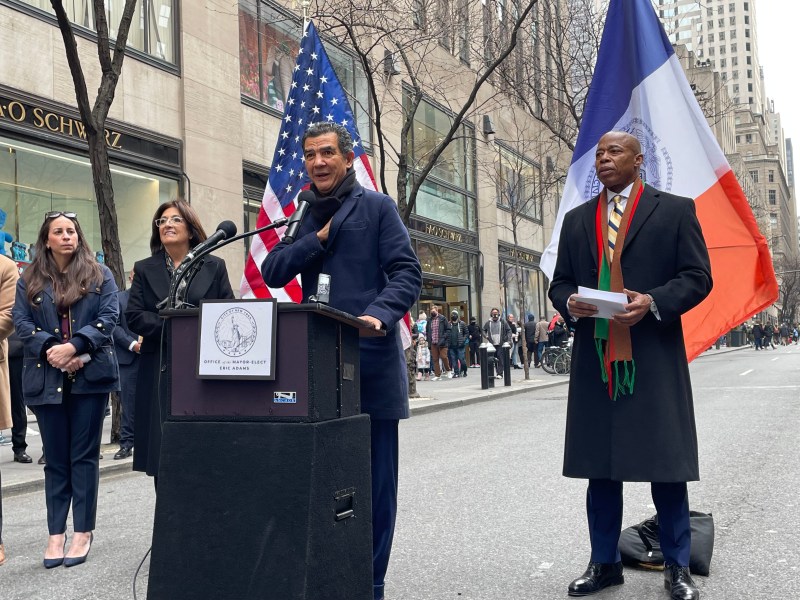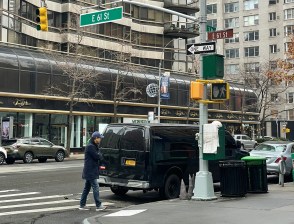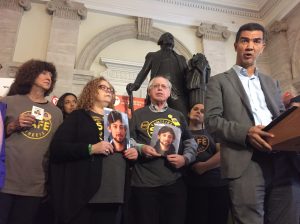Incoming DOT Commissioner Rodriguez Promises To Upgrade Half of the City’s Plastic-Protected Bike Lanes


Call him the Man of Steel.
Incoming Department of Transportation Commissioner Ydanis Rodriguez promised on Tuesday that his agency would quickly reinforce half of the city’s protected bike lanes.
“We are going to commit to replacing 50 percent of all plastic-protected bike lanes with sturdier and more permanent structures within the first 100 days,” Rodriguez said on Tuesday morning at a press conference where he was officially announced as incoming Mayor Eric Adams’s pick to run the sprawling $1.3-billion agency.
Rodriguez admitted he was light on the details on what would be a major, major overhaul of the city’s bike lane network, saying that the exact locations remained undecided, as well as what the upgrades would consist of. But he also vowed that he would hit the ground running from the moment he took over the DOT.
“It’s one of the things that we want,” he said. “We’re going to be looking at the whole city. On Day 1, I’m going to go to the agency and listen to the experts we have there, people who have decades of experience, and we’re going to look at where in the city we should start.”
The city has more than 546 miles of bike lanes classified as protected bike lanes. A spokesperson for the DOT could not immediately provide the mileage figure for lanes protected only by plastic rather than by Jersey barriers or a row of stored cars.
Still, activists welcomed the news that someone in charge saw a problem with the city’s current idea of protection.
“People on bikes need real protection and we know truly protected bike lanes are what keep bike riders and other road users safe on our streets,” said Transportation Alternatives Executive Director Danny Harris. “Upgrading the bike lane network is a much-needed and very promising first step from the next DOT commissioner.”
Cyclists have previously pointed out that the city’s use of plastic bollards in place of harder material like concrete or even steel has not led to a fully safe environment that encourages biking for all age levels, since plastic sticks do not prevent drivers from killing or maiming cyclists. So far this year, 18 cyclists have been killed and 4,818 cyclists have been injured, according to city statistics.
https://twitter.com/sqddxjQ48j/status/1410303164981645324
https://twitter.com/BarmanNYC/status/1397307583170584577
I just wanted to ride my #bikenyc to get dumplings for my daughter. But…
1. Much has been said about the stupid plastic bollards that create a “protected” #bikenyc lane. Also this should be instructive for @BayRidgeDrivers who think widening the road solves congestion. pic.twitter.com/9jSkiMUDgA— That Thing You Smell (@moogman2268) November 20, 2020
Candidates for local office have also pointed out that the city could do better than flimsy protection. “Plastic bollards do not work,” then-Manhattan Borough President candidate Elizabeth Caputo said at a Bike New York forum during election season.
@ElizabethCaputo's observations from the road: "Plastic bollards do not work. I see people weaving through them like it's in a sort of an agility course… It's not enough for people right now. We need to have full-on concrete bollards and fully-protected bike lanes." #bikenyc
— Bike New York (@bikenewyork) May 10, 2021
There’s also the question of how much more needs to be done beyond switching out skinny plastic sticks for steel, concrete or at the very least more threatening kinds of plastic. As Bike New York has tweeted in the past, thicker plastic bollards can be good protection that’s wasted on bike lanes wide enough to drive a truck through.
This is of course a laudable goal, but heavier barriers don’t fix the problem of bike lanes that are wide open to drive into at every intersection https://t.co/ugjL2ody0i pic.twitter.com/pRZSuP4Pfp
— Bike New York (@bikenewyork) December 21, 2021
“It’s a great sign that the new administration is responsive to the problem of very low quality ‘protected’ bike lanes, but we’d like to see some additional innovation and test cases where the lanes end up actually protected,” said Bike New York Director of Advocacy Jon Orcutt.
Bike lanes in the city have been kept unfortunately wide, and as a result somewhat ill-protected, for years due in part to the fact that the Department of Sanitation had neglected to purchase snow plows that were small enough to fit in narrow spaces. The Sanitation Department recently showed off its new fleet of bike lane-ready snow plows, those will be most useful if it actually snows heavily in the city. With a rapidly warming planet, those plows may have to beaten into sweepers.
As a result, one thing the next DOT should look at while hardening the lanes is explore designs that cap existing bike lanes so that cars and trucks can’t get into the lanes to begin with, Orcutt said. Of course, the issue there is whether the DOT and Sanitation are on the same page as far as using small enough street sweepers that can still clean the grit and grime off the asphalt.
“You can keep the bike lanes wide, and put a bollard in the center so only a skinny sweeper can get in. The living model for this today is on the West Side Greenway — there’s a total bollard exclusion of cars, and there are very skinny sweepers,” Orcutt said.



